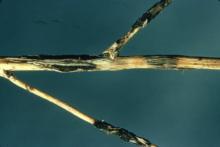Cause Puccinia asparagi, an autoecious macrocyclic rust fungus that overwinters on old asparagus stems. The summer spore stage, which is the most damaging stage, is windborne and may go through several cycles in a growing season. Reduced size and storage reserves in the crowns weakens plants and reduces yields the following season.
Symptoms The first signs of the disease in the spring are oval yellowish spots (aecia and pycnia) on stems. These spots, usually not abundant and often overlooked, contain fruiting bodies of the fungus. The summer spore stage appears as pustules (uredinia), blister-like in appearance, which break through the epidermis to expose brownish, powdery spore masses. In late summer and autumn, black spore masses (telia) appear in the same spots where the brown summer pustules were produced, or in separate pustules. When infection is widespread, plant vigor is reduced and the crop matures abnormally early.
Cultural control
- Plant only resistant varieties. The varieties, Jersey Knight, Jersey Giant, Jersey Centennial and UC-157 have greater resistance than varieties, California 500 and selections of Mary Washington.
- Cut or kill all volunteer asparagus in field or adjacent areas.
Chemical control Use when harvest is completed. May give only partial control of the summer stage.
- Chlorothalonil (Group M5) formulations are labeled.
- Bravo Ultrex at 1.8 to 3.6 lb/A in 25 to 50 gal of water/A on 14- to 28-day intervals. Begin applications after final harvest of spears. Do not apply within 190 days of harvest the following season. 12-hr reentry.
- Echo 720 at 2 to 4 pints/A on 2- to 4-wk intervals. Preharvest interval is 190 days. 12-hr reentry.
- Copper products (Group M1) are labeled but are not best used as stand-alone products. Avoid build-up of copper in soil.
- Badge SC at 1 to 2.5 pints/A on no shorter than 10-day intervals. Preharvest interval is 0 days. 48-hr reentry.
- Demethylation-inhibiting (DMI) Fungicides (Group 3) are labeled for use on 14-day intervals. Alternate with another effective fungicide labeled for use. Do not apply within 180 days of harvest.
- Rally 40WSP at 5 oz/A. 24-hr reentry.
- Tebustar 3.6L at 4 to 6 fl oz/A. 12-hr reentry.
- Tebuzol 3.6F at 4 to 6 fl oz/A. 12-hr reentry.
- JMS Stylet-Oil at 3 to 6 quarts/100 gal water. Do not spray if foliage is wet or if the temperature is below 50°F, above 90°F or when plants are under heat or moisture stress. 4-hr reentry. O
- Mancozeb products (Group M3) such as Manzate Flowable at 1.6 quarts/A or Penncozeb 75DF at 2 lb/A. Apply only on ferns after spears have been harvested. 24-hr reentry.
- Strobilurin fungicides (Group 11) are labeled for use. Do not make more than one (1) application of a Group 11 fungicide before alternating to a labeled fungicide with a different mode of action.
- Dexter Max (Group M3 + 11) at 2 to 2.2 lb/A on 10-day intervals. Preharvest interval is 180 days. 24-hr reentry.
- Dexter Xcel (Group M3 + 11 + 3) at 48 to 64 fl oz/A on 10-day intervals. Preharvest interval is 180 days. 24-hr reentry.
- Sulfur products (Group M2) are labeled for use.
- Thiolux (80% sulfur) at 10 to 30 lb/A. 24-hr reentry.
Biological control
- Sonata at 2 to 4 quarts/A on 7- to 14-day intervals. Can be applied up to and on the day of harvest. 4-hr reentry. O
References Johnson, D.A., and Lunden, J.D. 1992. Effect of rust on yield of susceptible and resistant asparagus cultivars. Plant Disease 76.84-86.
Waterson, J.M. 1965. Puccinia asparagi. CMI Descriptions of Pathogenic Fungi and Bacteria, No. 54. Surrey, England: Commonwealth Mycological Institute.


